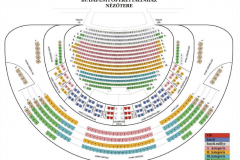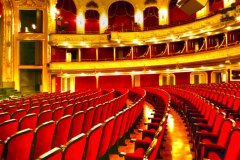The Csárdás Princess
December 2024 | ||||||
|---|---|---|---|---|---|---|
Mo | Tu | We | Th | Fr | Sa | Su |
Genre: Operett
Duration: 195 minutes
This is the first time that Attila Vidnyánszky, the director of the Hungarian National Theatre, has directed an operetta performance, and the world’s most famous one at that. Following its July preview performance at the Margaret Island Open Air Theatre, Imre Kálmán’s immortal masterpiece, the Csárdásfürstin, will join the repertoire of the Operetta Theatre from September 2019. This particularly lavish production of the oft-reconfigured play is based on the first Hungarian version produced by Andor Gábor in 1916. With its bohemian characters among the high nobility, its complicated plot involving matters of the heart and compelling melodies, the piece has become a memorial to light-heartedness itself; while the dark clouds heralding the dissolution of old Hungary and of the Austro-Hungarian Monarchy also appear on the horizon.
We would like to draw your attention to the fact that due to the special setting of the performance, the English subtitles are only partially visible from the upstairs auditorium, please take this into account when purchasing tickets.
Synopsis
Place: Budapest and Vienna
Time: shortly before the outbreak of the First World War
Act 1
Sylva Varescu, a self-sufficient and professionally successful cabaret performer from Budapest, is about to embark on a tour of America. Three of her aristocratic admirers, named Edwin, Feri, and Boni, prefer her to stay. Edwin, unaware that his parents have already arranged a marriage for him back home in Vienna, orders a notary to prepare a promissory note of his expected marriage to Sylva within ten weeks. Sylva then leaves on her American tour, and Edwin leaves for peacetime military duty.
Act 2
Just at the time this promissory note is about to expire, Sylva visits Edwin's palace in Vienna, pretending to have married Boni as her entrée into his family's society. Edwin is about to be engaged to Stasi, who does not care for him and wishes only an arranged marriage. Boni falls in love with Stasi and Edwin regrets not keeping his promise to Sylva sooner. However, Edwin makes the faux pas of informing Sylva that his parents would accept Sylva only if she pretends to have been divorced from Boni and therefore already entered society via an earlier marriage. Edwin's father separately informs Sylva that if she marries Edwin without first having achieved noble rank through some other route, her role in society could be merely that of a "csárdás princess." Sylva realizes that she is better than they and has a brighter future than they have. She purposefully embarrasses Edwin and his father, turning her back on them and leaving in the presence of their assembled friends.
Act 3
The act is set in a Viennese hotel to which Feri has accompanied the cabaret troupe from Budapest, who are about to sail on another American tour with Sylva. As everyone shows up and recognizes each other, Feri recognizes Edwin's mother as a retired cabaret singer from Budapest whose star once shone prior to Sylva's time. Edwin's mother joins the two couples, Sylva/Edwin and Boni/Stasi, all unwittingly heading to safety on this American tour.
Program and cast
Mónika Fischl: Szilvia Vereczki
Enikő Éva Lévai: Szilvia Vereczki
Diána Kiss: Szilvia Vereczki
Gábor Bakos-Kiss: Edwin Ronald
Zsolt Homonnay: Edwin Ronald
Péter Laki: Count Bóni Kaucsiánó
Attila Erdős: Count Bóni Kaucsiánó
Viktor Dénes: Count Bóni Kaucsiánó
Szilvi Szendy: Countess Stázi, the prince's niece
Luca Bojtos: Countess Stázi, the prince's niece
Flóra Széles: Countess Stázi, the prince's niece
Tünde Frankó: Anhilte, the prince's wife
Ágota Siménfalvy: Anhilte, the prince's wife
Lajos Csuha: Prince Leopold Mária, Duke of Lippert-Weilersheim
Gábor Dézsy Szabó: Prince Leopold Mária, Duke of Lippert-Weilersheim
Soma Langer: Lieutenant Eugen von Rohnsdorff
Zoltán Kiss: Ferkó Kerekes
József Virágh: Ferkó Kerekes
Tibor Szolnoki: Ferkó Kerekes
Patrik Görög: Miska
Gergely Altsach: Clerk
Conductor
Pfeiffer Gyula
Pál Rónai
Creators
Kálmán Imre - Composer
Jenbach Béla - Book
Leo Stein - Book
Andor Gábor - Hungarian translation
Mónika Szabó - Conductor of choir
Gombai Szabolcs - Assistant choreographer
Zsuzsanna Németh - Assistant choreographer
Marosi Edit - Assistant choreographer
Lenchés Márton - Assistant director
Tamás Bori - Artistic assistant
József Dreiszker - Light designer
Berzsenyi Krisztina - Costume designer
Balázs Cziegler - Set designer
Yvette Bozsik - Choreographer
Attila Vidnyánszky - Director
Budapest Operetta Theater
History
The history of the Operetta Theatre begins with the name of Károly Somossy who used to run an Orpheum in the building at 17 Nagymező street since 1884. In 1890 he bought the house and had it transformed into an entertainment house by the Felner and Helmer company, which opened in 1894. Its interior design was exalted by all accounts. Then the venture went bankrupt in 1899, Károly Albrech restaurant keeper took over the operation and from 1902 a Variety Show started to work there with the name of Fővárosi Orfeum, under the management of Imre Waldmann.
The Americal theatre entrepreneur, Ben Blumenthal, after having purchased the Vígszínházm also rented the Orpheum in 1922. The refurbished theatre opened its gates on 23 December 1922 first as Fővárosi Színház, a year later taking up the name of Fővárosi Operett Színház.
From 1929 to 1930 the Fővárosi Művész Színház (Arts Theatre) worked there with leadership of Gyula Kabos. From September 1930 the theatre took up again its old name and was lead by Dezső Sebestyén but it was forced to close several times because of the scanty attendance. From 1936 to 1938 it hosted the Arts Theatre of Artúr Bárdos.
After the siege of Budapest the theatre was opened in march 1945 with the popular operetta by Imre Kálmá, the Csárdáskirálynő. This soon became the biggest Hungarian and international success of the play. The theatre was nationalized in 1949, and Margit Gáspár appointed as director. The general renovation of the building had already been decided in 1960 but it was only realized in the second part of the sixties. In 1966 the company moved into the former building of the Petőfi Theatre, and the reconstruction started according to the plans of the Középüettervező Vállalat (Company of Public Constructions). The designers were: Halmi Iván, Pozsay Csaba és Vajda Ferenc. The festive opening was held on 17 April 1971, again with a staging of Csárdáskirálynő. This was the thousandth performance of Imre Kálmán’s operetta.
Imre Halasi, who used to be the manager of the theatre from 1996 to 2000, changed the name of the theatre form 1. January 1998. Since then it is called Budapesti Operettszínház (Budapest Operetta Theatre). Another reconstruction of the building can be tied to the name of Halasi, the aim of which was the restoration of the original milieu. The designer, Mária Siklós, tried to free the building from the construction errors that got there during the several earlier reconstruction.
In March 2002 a studio theatre for 100 people was inaugurated, the so called Storage Room Theatre situated in the theatre’s wing in Mozsár street.
Architectural description
The unique character the theatre comes from the interesting features of the plot division. The main facade and the entrance of the Budapest Operetta Theatre opens from the Nagymező Street, however the functions of the theatre are built in to the inside courtyards framed by houses between the Andrássy, Nagymező and Mozsár streets. Therefore the mass of the auditorium and the flyloft is not perceptible from the street.
The two-storey mass of the main facade was built at the turn of the century, according to the plans of the famous Viennese theatre designer duo, Ferdinand Fellner and Herman Helmer. The entrance axe is surrounded at the entire height of the building by arched closed pediment. The entrance projection is articulated with two opening axes. The windows on the first floor are squared closed, while those on the second floor are arched. On the attics closing this part of the building on the complete with of the projection stands a lyre indicating the function of the building.
The side wings are articulated with three opening axes and pilasters, which surround the first and second floors. Between the ground and first floor a dividing edge and balusters run around. The first floor openings are arched, while those on the second floor are squared, closed with decorative frame and keystone. The ground floor surface is horizontally pointed. The wall plane of the storeys is punch coloured; the pilasters, the sides, the ornaments and the window frames are white.
The auditorium is fan-shaped with balconies on the first and second floor. The stage is framed with accented proscenium wall and proscenium boxes.

 EN
EN DE
DE IT
IT FR
FR ES
ES RU
RU JP
JP RO
RO
 Seating plan
Seating plan 